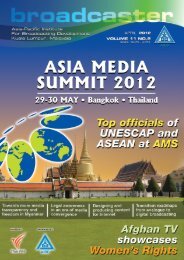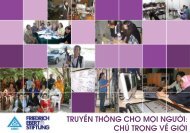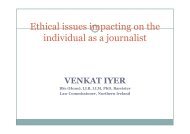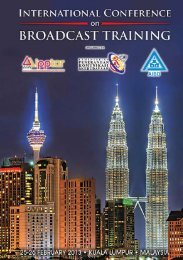Co-productions
Broadcaster 042013.pdf - AIBD
Broadcaster 042013.pdf - AIBD
- No tags were found...
Create successful ePaper yourself
Turn your PDF publications into a flip-book with our unique Google optimized e-Paper software.
ICBT Makes Successful Debut<br />
By Mr. Yang Binyuan, AIBD Director<br />
The 1st International <strong>Co</strong>nference on<br />
Broadcast Training (ICBT) was successfully<br />
concluded in Kuala Lumpur where we saw<br />
a diversity of sharing and engagement in<br />
understanding the impact of the evolving<br />
media landscape and in identifying models<br />
to build the training institutions of today and<br />
of the future.<br />
In this <strong>Co</strong>nference, we examined models to<br />
nurture an agile and learning organization for<br />
innovation and performance. What is key is<br />
to build more exchanges, relationships and<br />
engagement if we are to survive and to be of<br />
value to our audience.<br />
Broadcaster<br />
During the two-day <strong>Co</strong>nference from 25-26<br />
February 2013, participants learned how<br />
information, technology and our audience<br />
are moving fast and we in the broadcast<br />
industry, particularly broadcast trainers need<br />
to catch up, revisit existing approaches, and<br />
address the increasing demands of digital<br />
technology and social media. We need to<br />
work towards a performance driven culture<br />
that contributes to the company’s growth<br />
and sustainability, increased customer<br />
satisfaction and contribution to society.<br />
One such model presented is the use of<br />
the S analysis model that allows broadcast<br />
leaders to review their structure, systems,<br />
style, staff, skills, and strategy and come<br />
out with shared values critical in building<br />
and delivering training programmes.<br />
Another is to use e-learning, and cloud<br />
technology to make training programs<br />
relevant, efficient and convenient. Still<br />
another is to design a training program that<br />
is customized and individualized to enhance<br />
teaching and learning.<br />
Another highlight of the <strong>Co</strong>nference was to<br />
identify specific steps to address the human<br />
resource needs in the digital migration<br />
process. What was important was to engage<br />
all stakeholders in facilitating understanding<br />
and acceptance of moving towards digital<br />
technology.<br />
To offer creative and entertaining content,<br />
the <strong>Co</strong>nference also discussed the demands<br />
of sourcing good original ideas and wellresearched<br />
material, with a good character<br />
development and good acting, with believable<br />
/ natural dialogues.<br />
In attracting and retaining talents, the<br />
<strong>Co</strong>nference identified ways to build a winning<br />
team provide a dynamic and challenging<br />
environment and address increasing needs<br />
for good compensation, career advancement<br />
and work/life balance.<br />
We specifically noted the need to adhere<br />
to an organization’s core values that can<br />
contribute towards the recruitment of good<br />
talents. We must focus on recruiting people<br />
for the jobs of the future for new media and<br />
social media and for the next generation of<br />
content makers who have different ways of<br />
accessing information and entertainment<br />
material, of viewing and consuming material,<br />
and of creating their own content for social<br />
media and mobile phones.<br />
In my closing remarks at the <strong>Co</strong>nference, I<br />
expressed AIBD’s sincere thanks to all our<br />
speakers, chairpersons, and participants<br />
as well as the main partner, IPPTAR, led<br />
by Dato’ Adilah Shek Omar, who ensured a<br />
successful conference.<br />
To be of value to the changing consumer<br />
behavior, broadcast stations need to<br />
strengthen the new media features of their<br />
TV programs and provide more audience<br />
interaction through the multi-media<br />
platforms. Training through international<br />
exposure can be useful to gain a global<br />
view of how international broadcast<br />
companies produce creative programmes,<br />
and serve as inspirations to attract audience<br />
participation.<br />
Finally, the <strong>Co</strong>nference identified various<br />
criteria to address training obstacles in<br />
technology, skills deficiency, and funding<br />
among others to strengthen training<br />
institutions to deliver results and solutions<br />
to meet organization’s objectives and the<br />
demands of the ever-changing media<br />
environment.<br />
5








